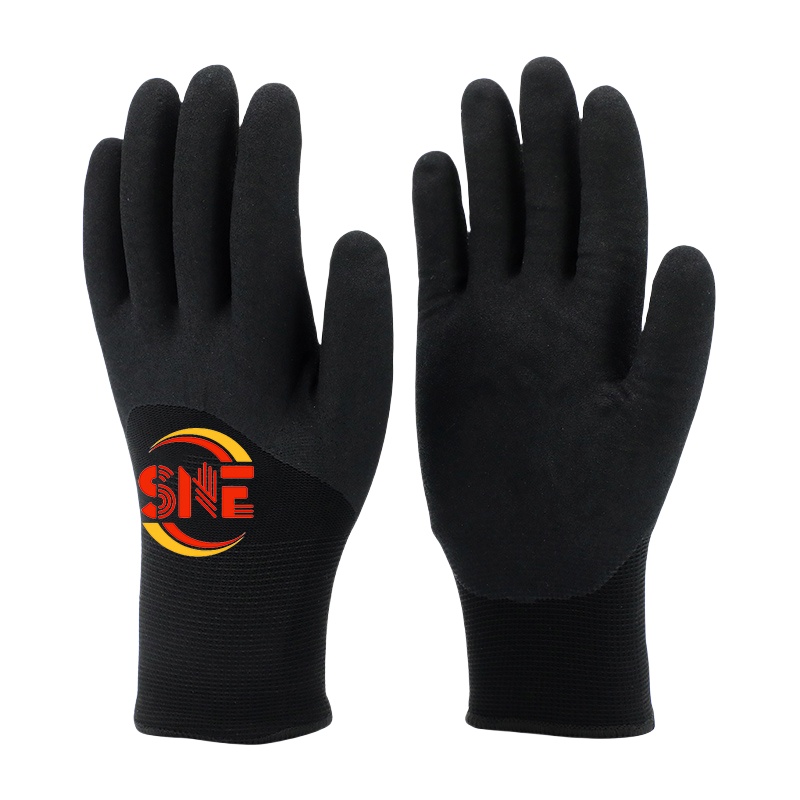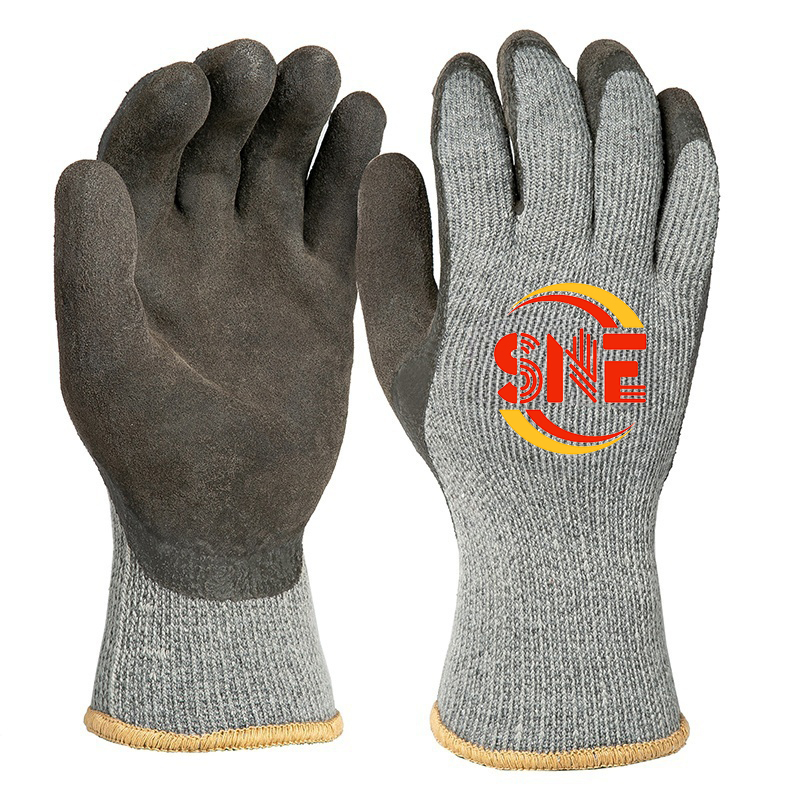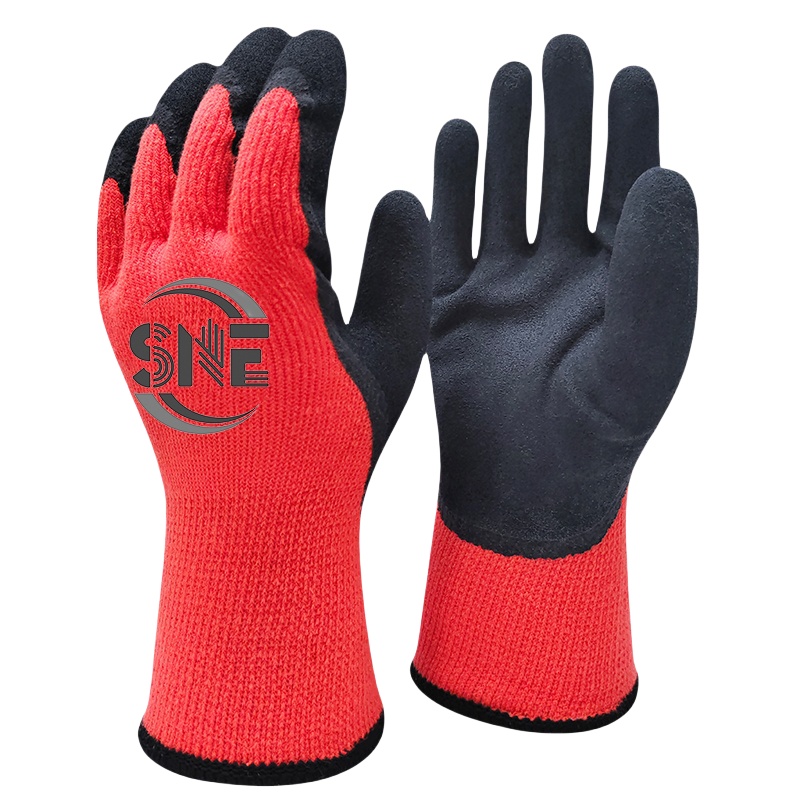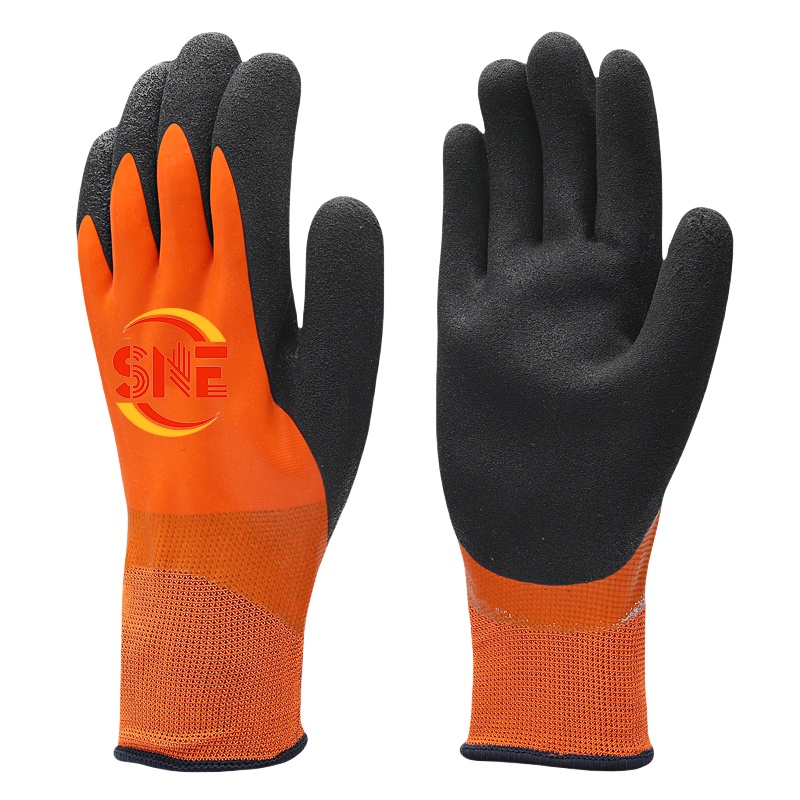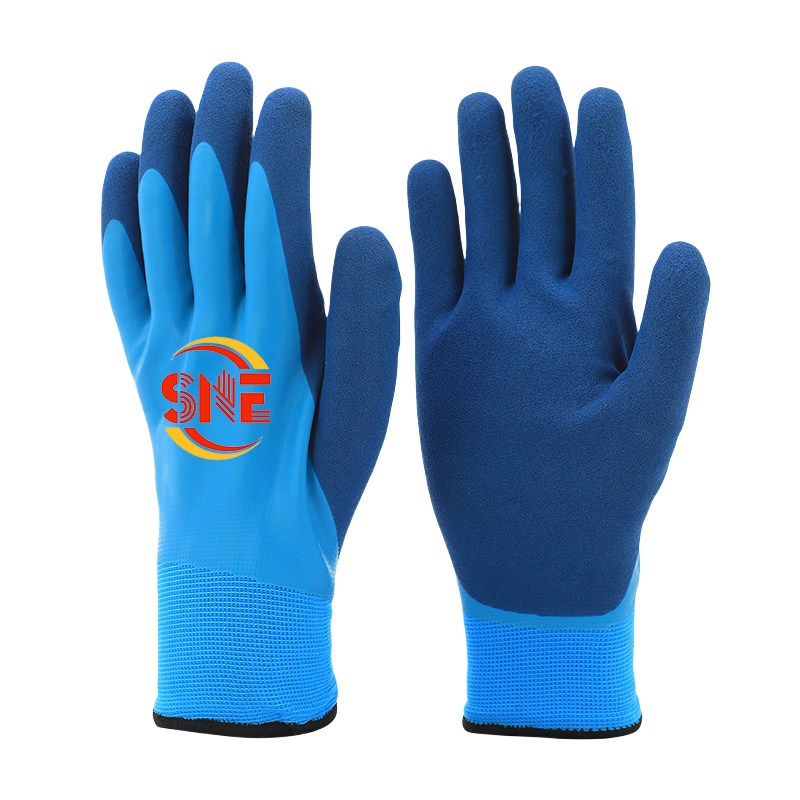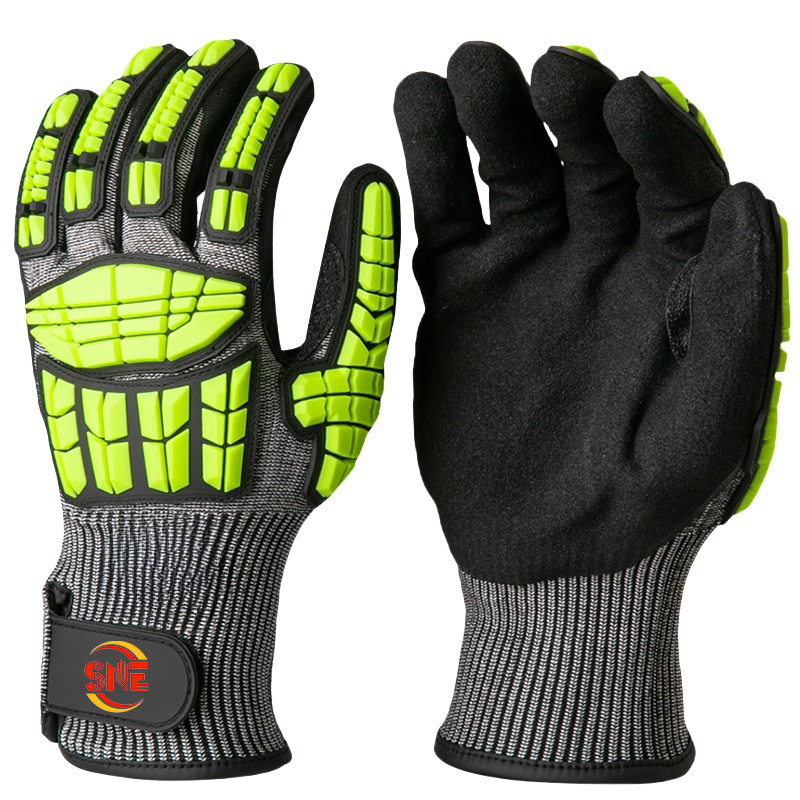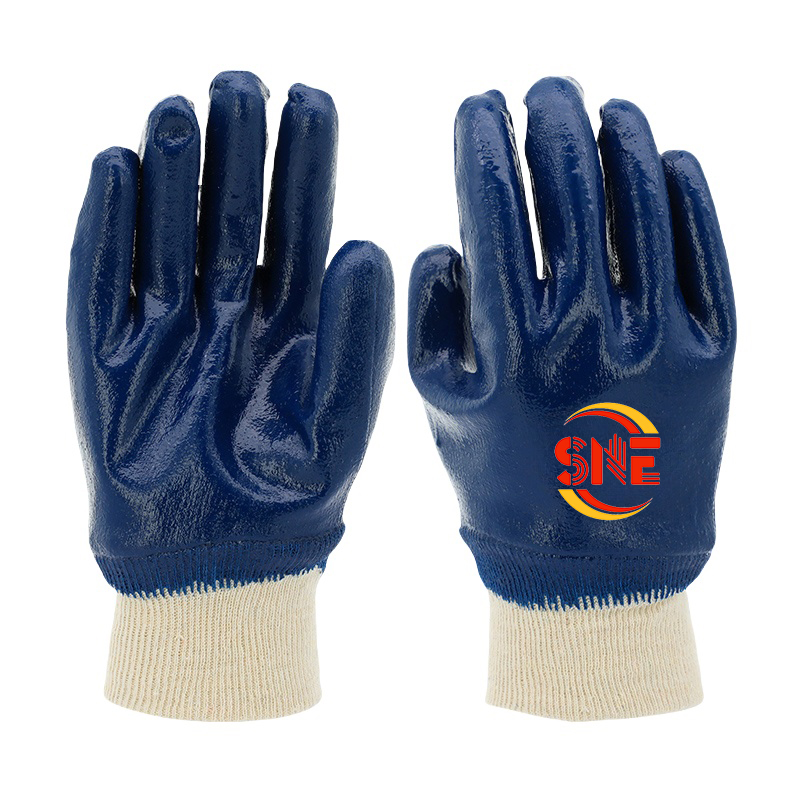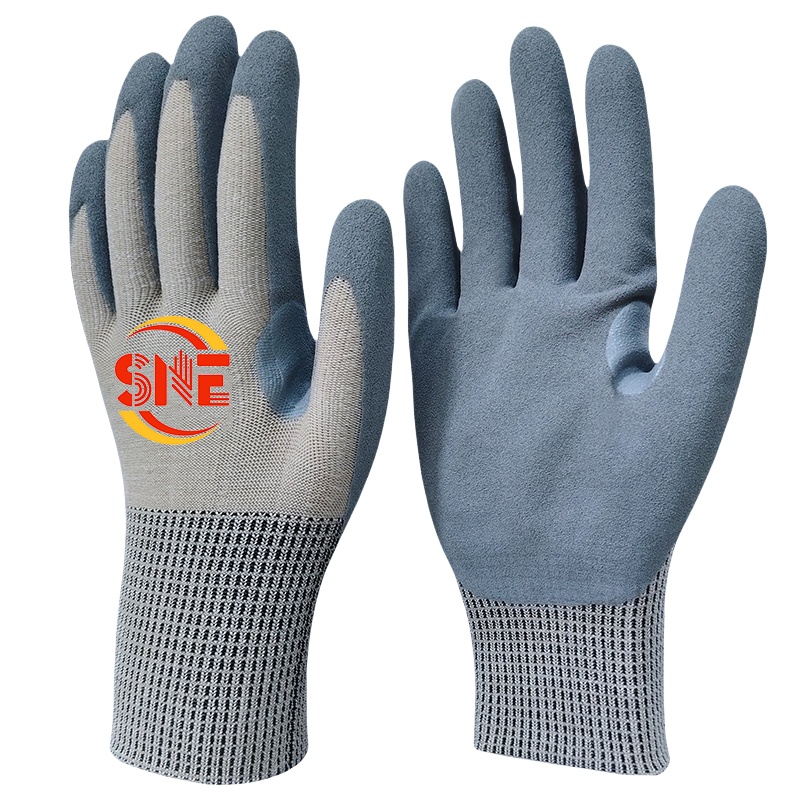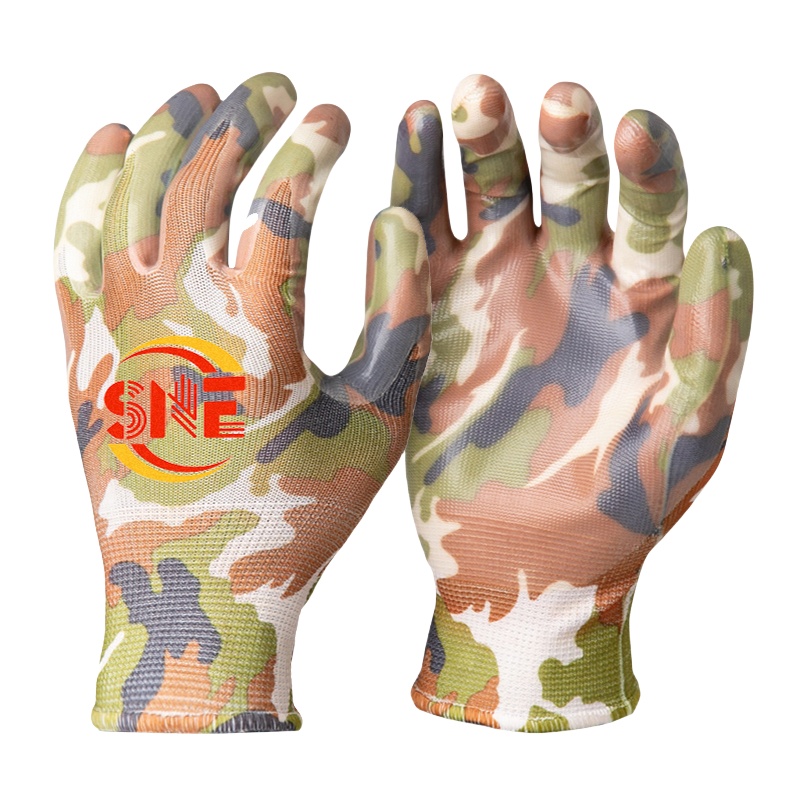OEM Cold Protection Gloves Factory in 2025: Complete Manufacturing Guide
October 16, 2025
Share This Article
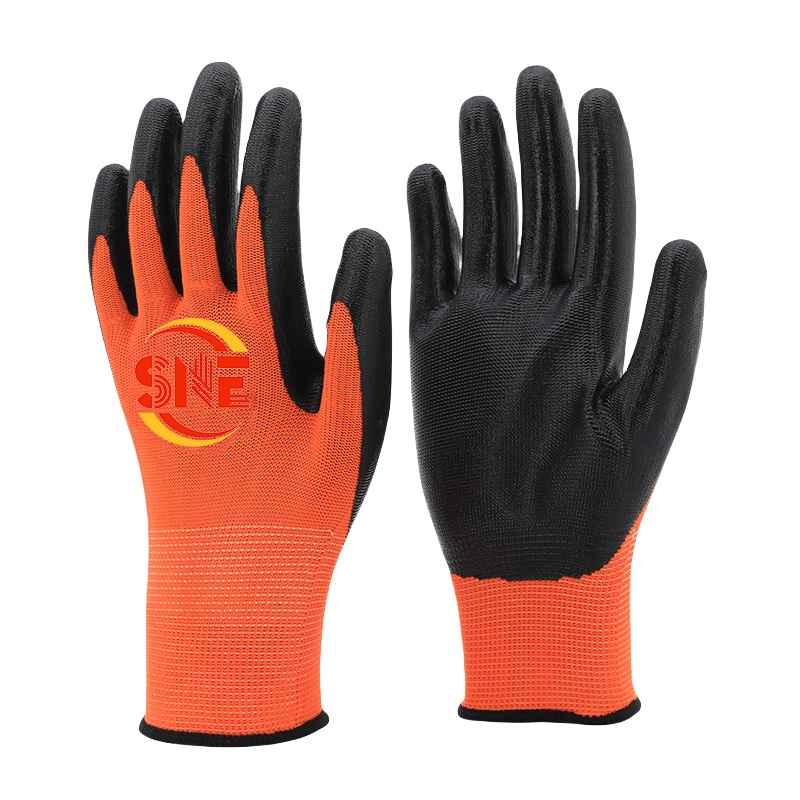
In today’s industrial landscape, protecting workers’ hands from extreme cold conditions isn’t just about comfort—it’s essential for safety, productivity, and regulatory compliance. As global industrial activities continue expanding into cold environments, the demand for specialized cold protection gloves has surged dramatically. This comprehensive guide explores everything you need to know about OEM cold protection gloves manufacturing, helping you navigate the complex world of cold-resistant hand protection solutions.
What are Cold Protection Work Gloves?
Cold protection work gloves are specialized hand protection equipment designed to shield workers’ hands from extreme cold environments while maintaining dexterity, grip, and comfort. Unlike regular work gloves, cold protection variants incorporate specific materials, insulation technologies, and construction methods to retain heat, resist moisture penetration, and provide adequate protection against cold-related hazards.
These gloves are essential in various industries including cold storage facilities, outdoor construction during winter months, refrigeration work, cryogenic handling, oil and gas operations in cold climates, and winter maintenance activities. The primary function extends beyond simple warmth – they prevent serious cold-related injuries such as frostbite, hypothermia, and reduced motor skills that could lead to workplace accidents.
Modern cold protection gloves typically feature a multi-layer construction:
- Outer shell: Durable materials that resist abrasion and provide initial protection
- Insulation layer: Specialized materials that trap body heat
- Moisture barrier: Membranes or treatments that prevent water penetration while allowing moisture vapor to escape
- Inner lining: Soft, comfortable materials that provide additional warmth and wick away perspiration
The technology behind these specialized gloves has evolved significantly, with innovations like phase-change materials, advanced synthetic insulations, and ergonomic designs that maintain dexterity even in sub-zero temperatures. As workplace safety standards continue to evolve, cold protection gloves have become increasingly sophisticated, offering targeted solutions for specific industry needs.
How to Choose the Best Cold Protection Gloves for Your Business?
Selecting the right cold protection gloves for your specific business needs requires careful consideration of multiple factors. The optimal choice balances protection requirements, worker comfort, operational efficiency, and cost-effectiveness. Here’s a comprehensive approach to finding the perfect cold protection gloves for your business:
1. Understand Your Temperature Requirements
Begin by accurately assessing the actual temperature range your workers will face. Cold protection gloves are typically rated for specific temperature ranges:
- Mild cold (32°F/0°C to 50°F/10°C): Lighter insulation sufficient
- Moderate cold (14°F/-10°C to 32°F/0°C): Medium insulation required
- Extreme cold (Below 14°F/-10°C): Heavy insulation with specialized features necessary
2. Evaluate Required Dexterity and Grip
Consider the precision tasks your workers perform:
- High dexterity needs (electronics assembly, precision mechanics): Choose thinner insulation with articulated finger designs
- Medium dexterity (general maintenance, logistics): Balanced insulation with reinforced grip areas
- Low dexterity requirements (outdoor surveillance, brief cold exposure): Prioritize warmth over finger mobility
3. Assess Exposure Duration
The length of time workers spend in cold environments significantly impacts glove selection:
- Short exposures (minutes): Lighter options may suffice
- Medium exposures (1-3 hours): Balanced insulation with moisture management
- Extended exposures (full shifts): Maximum insulation with features like extended cuffs and supplemental heating options
4. Consider Industry-Specific Requirements
Different industries have unique requirements:
- Food processing: Food-safe materials with washable properties
- Chemical handling: Cold-resistant materials that also provide chemical protection
- Electrical work: Insulation that doesn’t compromise electrical safety standards
- Oil and gas: Flame-resistant properties combined with cold protection
5. Evaluate Additional Protection Needs
Many cold environments present multiple hazards:
- Impact protection: Look for TPR (thermoplastic rubber) reinforcements
- Cut resistance: Seek gloves with appropriate ANSI cut level ratings
- Waterproofing: Essential for wet and cold environments
- Vibration dampening: Important for equipment operators in cold conditions
Working with a specialized manufacturer like Qingdao Snell Protective Products can help navigate these complex requirements. With over 10 years of expertise in protective glove manufacturing, Snell offers custom cold protection solutions that precisely match your business requirements while maintaining competitive pricing and ensuring all necessary certifications are met.
Latest Innovations in Cold Protection Gloves Manufacturing for Industrial Use
The cold protection gloves industry has witnessed remarkable technological advances in recent years, revolutionizing how workers in cold environments stay protected while maintaining productivity. These innovations address longstanding challenges of balancing thermal protection with comfort and functionality.
Advanced Insulation Technologies
Traditional insulation materials like Thinsulate™ are being enhanced and complemented by cutting-edge alternatives:
- Aerogel Insulation – Originally developed for NASA, aerogel is now being incorporated into industrial gloves. This ultra-lightweight silica-based material provides superior thermal insulation with minimal bulk, maintaining dexterity while offering protection in temperatures as low as -200°F (-129°C).
- Phase Change Materials (PCMs) – These smart materials absorb, store, and release heat as needed. When a worker’s hand heats up, the PCM absorbs excess heat; when temperatures drop, it releases stored heat back to the hand, maintaining optimal comfort.
- Hollow-Fiber Synthetic Insulation – These engineered fibers trap more air than solid fibers while reducing weight, providing excellent warmth-to-weight ratios and maintaining insulating properties even when compressed.
Smart Heating Systems
Battery-powered heating has evolved beyond simple resistance wires:
- Micro-Carbon Fiber Heating – These systems distribute heat more evenly across the entire hand, targeting cold-sensitive areas like fingertips.
- Smart Temperature Regulation – Advanced gloves incorporate thermostat controls that automatically adjust heating based on external temperatures and user activity levels.
- Rechargeable Power Systems – Modern heated gloves utilize lightweight lithium-polymer batteries with improved capacity, offering full-shift protection without bulky power packs.
Enhanced Moisture Management
Keeping hands dry is crucial for thermal comfort and protection:
- Hydrophobic Nano-Coatings – These microscopic treatments repel water while maintaining breathability, preventing outer layers from becoming saturated in wet conditions.
- Bi-Component Wicking Systems – Advanced inner linings use dual-material constructions that actively pull moisture away from the skin and disperse it for faster evaporation.
- Selective Permeability Membranes – These advanced materials block liquid water while allowing water vapor to escape, maintaining dryness without condensation buildup inside the glove.
Ergonomic Design Innovations
Cold-induced stiffness is being addressed through innovative construction methods:
- Pre-Curved Finger Construction – Gloves manufactured in a naturally curved position reduce hand fatigue during gripping tasks.
- Articulated Joint Panels – Strategic flex zones at key hand joints maintain mobility without compromising insulation.
- Task-Specific Reinforcement – Modern manufacturing processes allow reinforcement to be precisely applied only where needed, eliminating bulk in areas requiring maximum dexterity.
Qingdao Snell Protective Products Co., Ltd. has been at the forefront of implementing these innovations in their manufacturing processes. Their commitment to research and development has resulted in cold protection gloves that incorporate many of these advanced features while maintaining competitive pricing. Their direct factory model eliminates middlemen, allowing industrial customers to access these technological advantages at reasonable price points.
What Are the Most Durable Materials for Cold Protection Gloves?
When it comes to cold protection gloves, durability is as important as thermal insulation. The most effective cold protection gloves combine materials that withstand harsh conditions while providing necessary warmth. Here’s a comprehensive analysis of the most durable materials currently used in cold protection glove manufacturing:
Outer Shell Materials
The outer layer serves as the first line of defense against physical hazards while protecting the insulation layers beneath. The most durable options include:
1. Full-Grain Leather Varieties
- Cowhide: Offers excellent abrasion resistance with good balance of durability and flexibility. Best for general industrial applications.
- Goatskin: Provides superior tactile sensitivity while maintaining good durability. Ideal for precision work in cold environments.
- Buffalo/Bison leather: Extremely durable with natural water resistance. Excellent for heavy-duty applications in wet and cold conditions.
2. Engineered Synthetic Shells
- Ripstop Nylon: Incorporates reinforcement threads that prevent tears from spreading. Highly resistant to punctures and abrasions.
- Ballistic Nylon: Originally developed for military body armor, this ultra-tough material withstands extreme abuse in cold environments.
- TPU (Thermoplastic Polyurethane) Overlays: Applied to high-wear areas, these flexible but extremely durable reinforcements extend glove life significantly.
3. Hybrid Materials
- Kevlar®-Reinforced Fabrics: Combining synthetic base materials with Kevlar fibers creates exceptional tear and puncture resistance.
- Cordura®: This advanced nylon fabric offers up to 3x the durability of standard nylon with excellent cold-temperature performance.
Insulation Materials with Superior Durability
The insulation layer must maintain its thermal properties even after compression and repeated use:
1. Synthetic Insulations
- PrimaLoft® Gold: Maintains 98% of warmth even when wet and resists compression over time.
- 3M™ Thinsulate™ Platinum Insulation: Provides excellent durability through extensive washing and use cycles while maintaining thermal efficiency.
- Hollow-fill Polyester: Recovers shape effectively after compression, maintaining insulating properties throughout the glove’s lifespan.
2. Natural Insulations
- Wool-Synthetic Blends: Combining wool’s natural insulating properties with synthetic durability creates insulation that withstands repeated use.
Palm and Grip Surface Materials
These high-wear areas require specialized durability treatments:
1. Silicone-Infused Materials
- Micro-pattern silicone coating provides excellent grip while resisting abrasion from repeated handling of rough materials.
2. PVC Dot Patterns
- Strategic placement of PVC dots offers enhanced grip and extended wear resistance in key contact areas.
3. Kevlar® Thread Reinforcement
- Critical seams reinforced with Kevlar thread maintain structural integrity despite repeated stress and flexing in extreme conditions.
Qingdao Snell Protective Products Co., Ltd. has developed expertise in combining these durable materials into effective cold protection gloves. Their manufacturing processes include specialized bonding techniques that prevent delamination between layers, a common failure point in lesser-quality gloves. With ISO9001 and CE certification, their quality control processes ensure consistent durability across production lots.
For businesses requiring gloves that withstand particularly harsh conditions, Snell offers customized material combinations, reinforcing specific areas based on wear pattern analysis from customer feedback. This approach maximizes durability where it’s most needed while maintaining flexibility and comfort everywhere else.
How to Ensure Quality Control for Cold Protection Gloves?
Maintaining consistent quality in cold protection gloves manufacturing is essential for worker safety and regulatory compliance. A robust quality control system encompasses every stage from raw material selection through production to final product testing. Here’s a comprehensive approach to ensuring exceptional quality in cold protection gloves:
Pre-Production Quality Control
The foundation of quality begins before manufacturing starts:
1. Raw Material Verification
- Implement comprehensive testing of all incoming materials against established specifications
- Conduct thermal efficiency testing of insulation materials under standardized conditions
- Verify certification documentation for specialized materials (chemical resistance, flame retardancy)
- Perform batch testing for consistency across material shipments
2. Component Compatibility Testing
- Assess how different materials interact under cold conditions
- Check for adverse chemical reactions between adhesives and shell materials
- Verify that material combinations maintain flexibility at target temperature ranges
3. Design Validation
- Create multiple prototypes for field testing before full production
- Conduct thermal imaging analysis to identify potential cold spots
- Use 3D modeling and simulation to predict stress points and potential failure areas
In-Process Quality Control
Maintaining quality standards throughout production requires systematic monitoring:
1. Production Line Checkpoints
- Establish inspection stations at critical manufacturing stages
- Implement statistical process control (SPC) with defined tolerance limits
- Use digital imaging systems to detect stitching inconsistencies
- Monitor adhesive application temperature and coverage for laminated components
2. Construction Standards Verification
- Measure seam strength through randomized pull testing
- Verify stitch count consistency in critical junctures
- Check layer alignment in multi-component gloves
- Assess cuff closure mechanisms for secure fit
3. Mid-Production Testing
- Conduct batch sampling for partial production runs
- Implement corrective actions before completing full production cycle
- Perform accelerated wear testing on samples from current production
Post-Production Testing
Final quality verification ensures only conforming products reach customers:
1. Thermal Performance Testing
- Measure heat retention using standardized methods like thermal resistance (Rct) testing
- Conduct cold chamber testing at specified temperatures
- Verify performance after exposure to moisture or other environmental factors
2. Mechanical Testing
- Assess tensile strength of materials and seams
- Measure abrasion resistance using standardized testing methods
- Conduct puncture and tear resistance testing
- Verify dexterity preservation using standardized protocols like EN 420
3. Compliance Verification
- Ensure all regulatory labeling requirements are met
- Verify conformity with applicable standards (EN 511, ANSI 105-2016, etc.)
- Maintain documentation for traceability and certification requirements
Qingdao Snell Protective Products Co., Ltd. has implemented a comprehensive quality control system that addresses all these aspects. Their ISO 9001 certification demonstrates their commitment to quality management processes, while their CE-certified products meet stringent European standards for personal protective equipment.
Snell’s quality control laboratory includes specialized equipment for cold environment testing, including thermal chambers that can simulate temperatures from -40°C to +70°C. This allows them to verify glove performance under actual use conditions. Additionally, their in-house quality assurance team conducts more than 30 different tests on each production batch, ensuring consistent performance across all products.
Compliance and Certifications Required for Cold Protection Gloves in Different Markets
Navigating the complex landscape of regulatory requirements for cold protection gloves is crucial for manufacturers and distributors. Different regions have established specific standards to ensure these critical safety products provide adequate protection. Understanding these requirements is essential for market access and legal compliance.
North American Certification Requirements
ANSI/ISEA 105-2016
The American National Standards Institute standard specifically addresses cold protection through its thermal classification:
- Includes tests for both conductive cold resistance and convective cold resistance
- Categorizes gloves on a 1-4 scale for thermal insulation properties
- Requires documentation of testing methods and results
ASTM F2137
This standard test method evaluates thermal insulation of gloves:
- Measures the resistance to heat transfer through glove materials
- Utilizes a thermal hand model to simulate real-world conditions
- Provides quantifiable data on how well gloves insulate against cold
OSHA Regulations
While the Occupational Safety and Health Administration doesn’t specify exact cold protection glove standards, employers must:
- Conduct workplace hazard assessments
- Provide appropriate PPE including adequate cold protection
- Train employees on proper glove use and limitations
- Document compliance efforts in cold environments
European Union Certification Requirements
EN 511:2006
This is the primary European standard for cold protection gloves:
- Tests three critical properties:
- Resistance to convective cold (performance level 0-4)
- Resistance to contact cold (performance level 0-4)
- Water penetration resistance (0 for water penetration after 30 min, 1 for no penetration)
- Requires CE marking for market access
- Mandates comprehensive user instructions
EU PPE Regulation 2016/425
This overarching regulation categorizes cold protection gloves:
- Most cold protection gloves fall under Category II (intermediate risk)
- Extreme cold protection gloves may qualify as Category III (complex risks)
- Requires EU Declaration of Conformity and specific documentation
- Mandates regular quality assurance monitoring for Category III products
CE Marking Process
To obtain CE marking for cold protection gloves:
- Perform risk assessment and identify applicable standards
- Conduct testing through a Notified Body
- Compile technical documentation
- Issue Declaration of Conformity
- Apply CE marking to products and packaging
Asian Market Requirements
China GB Standards
China has developed national standards for protective gloves:
- GB/T 12624 addresses general requirements for protective gloves
- Specific standards for cold protection including thermal testing
- CCC (China Compulsory Certification) may apply to certain protective equipment
Japan JIS Standards
Japanese Industrial Standards for protective equipment:
- JIS T 8127 addresses gloves for protection against cold
- Testing methods align with international standards but with specific Japanese requirements
- Voluntary but often expected by Japanese buyers
South Korean KS Standards
Korean Standards for protective equipment:
- KS K ISO 15383 covers protective gloves
- Alignment with ISO standards but with domestic certification process
- KOSHA (Korea Occupational Safety and Health Agency) certification recommended
Qingdao Snell Protective Products Co., Ltd. has extensive experience navigating these complex certification requirements. Their products undergo rigorous testing to meet both CE and ISO standards, ensuring global market access. With dedicated regulatory compliance specialists on staff, Snell maintains up-to-date certifications and adapts quickly to changing requirements. Their cold protection gloves meet or exceed the necessary standards for North American, European, and Asian markets, providing businesses with confidence that their purchases will comply with local regulations wherever they operate.
How to Customize Cold Protection Gloves with Your Logo and Branding?
Customizing cold protection gloves with your company’s logo and branding creates powerful benefits beyond simple brand recognition. Custom-branded gloves reinforce safety culture, increase compliance through pride of ownership, provide instant visual verification that proper PPE is being used, and serve as walking advertisements for your company’s commitment to worker safety. Here’s a comprehensive guide to creating effective customized cold protection gloves:
Customization Options and Techniques
1. Embroidery
- Ideal for: Durable, premium appearance on leather or heavy fabric exteriors
- Process: Computer-guided stitching creates raised, textured logos
- Advantages: Extremely durable, professional appearance, maintains visibility in dirty environments
- Limitations: Limited color complexity, minimum size requirements, not suitable for waterproof areas
- Best used on: Cuffs, back of hand areas on leather or heavy-duty fabric gloves
2. Screen Printing
- Ideal for: Bold, simple designs with limited colors
- Process: Ink applied through screens directly onto glove materials
- Advantages: Cost-effective for large quantities, works on various materials
- Limitations: Less durable than embroidery, limited detail capability
- Best used on: Cuffs, back of hand areas, larger branding elements
3. Heat Transfer
- Ideal for: Complex, multi-color designs with fine details
- Process: Digital printing onto transfer material, then heat-applied to gloves
- Advantages: Excellent color reproduction, fine detail capability, relatively durable
- Limitations: May crack in extreme cold if poor quality transfers are used
- Best used on: Back of hand, cuff areas where flexibility is less critical
4. Silicone Printing
- Ideal for: Grip-enhanced logos that serve functional and branding purposes
- Process: Silicone ink applied in patterns that create raised surface
- Advantages: Adds functionality through improved grip, highly durable
- Limitations: Limited color options, works best with simpler designs
- Best used on: Palm areas where grip is important, can combine branding with functional elements
5. Laser Etching
- Ideal for: Subtle, permanent branding on leather gloves
- Process: Laser burns away surface material to create permanent marks
- Advantages: Impossible to wear off, professional appearance, can include fine details
- Limitations: Limited to leather or similar materials, monochrome only
- Best used on: Premium leather cold protection gloves for permanent identification
Strategic Placement Considerations
Visibility vs. Functionality:
- High visibility placements: Back of hand, cuff area, finger sides
- Low wear areas: Gauntlet portion, cuff edges, wrist area
- Avoid: Palm center, fingertips, and other high-abrasion areas unless using extremely durable methods
Safety Considerations:
- Ensure branding elements don’t compromise thermal properties
- Avoid thick patches that could reduce dexterity in critical areas
- Consider reflective branding elements for added visibility in low-light conditions
Customization Process with Qingdao Snell
Qingdao Snell Protective Products Co., Ltd. offers comprehensive customization services for cold protection gloves. Their process ensures high-quality results that maintain the protective properties of the gloves:
- Design Consultation: Their design team works with clients to determine optimal branding placement and methods based on glove materials and intended use environment.
- Digital Proofing: Before production, Snell provides digital mockups showing exact placement, sizing, and appearance of customization elements.
- Sample Production: For large orders, sample gloves are produced for approval before full production begins.
- Quality Control: All customized elements undergo the same rigorous testing as the gloves themselves to ensure durability in cold environments.
- Documentation: Customization specifications are documented for easy reordering and consistency across future purchases.
Qingdao Snell can accommodate minimum order quantities (MOQ) starting from 3,000 pairs for customized cold protection gloves, making their services accessible to mid-sized operations while still offering economies of scale for larger orders up to 20,000 pairs. Their factory-direct model eliminates middlemen, keeping customization costs reasonable while maintaining high quality.
How to Find a Reliable OEM Cold Protection Gloves Factory in China, Vietnam, or India?
Finding a trustworthy OEM cold protection gloves manufacturer in Asia requires a methodical approach that balances quality, capability, and cost considerations. The right manufacturing partner can provide competitive advantages through specialized expertise, cost efficiency, and production flexibility. Here’s a comprehensive guide to identifying and vetting reliable cold protection glove factories in the major manufacturing hubs:
Key Sourcing Regions: Comparative Advantages
China Manufacturing Landscape
- Strengths: Advanced manufacturing technology, comprehensive supply chains, experienced workforce
- Major Manufacturing Hubs: Qingdao, Guangdong, Zhejiang, and Jiangsu provinces
- Specialization: High-tech thermal materials, integrated production capabilities
- Cost Considerations: Higher than Vietnam/India but typically offers better quality consistency
Vietnam Manufacturing Landscape
- Strengths: Growing manufacturing expertise, competitive labor costs, improving infrastructure
- Major Manufacturing Hubs: Ho Chi Minh City, Hanoi, and Da Nang industrial zones
- Specialization: Textile-based cold protection gloves, assembly operations
- Cost Considerations: Generally 10-15% lower than China with reasonable quality
India Manufacturing Landscape
- Strengths: English-speaking management, well-established textile industry, competitive pricing
- Major Manufacturing Hubs: Mumbai, Chennai, and Delhi regions
- Specialization: Natural fiber components, leather work, labor-intensive processes
- Cost Considerations: Potentially lowest production costs but often with longer lead times
Essential Verification Steps for Manufacturer Selection
1. Preliminary Qualification Process
- Verify business registration and operating licenses
- Check minimum of 5 years operational history for stability
- Review existing product portfolio for cold protection experience
- Assess production capacity documentation
- Evaluate initial communication responsiveness and English proficiency
2. Certification and Compliance Verification
- Confirm relevant certifications (ISO 9001, CE, etc.)
- Verify test reports from accredited laboratories
- Check social compliance audits (BSCI, SMETA, etc.)
- Review environmental compliance documentation
- Ensure proper export licensing
3. Manufacturing Capability Assessment
- Evaluate raw material sourcing capabilities
- Assess equipment sophistication and production techniques
- Review quality control procedures specifically for thermal properties
- Check production capacity and current utilization
- Evaluate sample development capabilities
4. Due Diligence Investigation
- Request and check customer references
- Conduct background checks through trade associations
- Research online presence and reputation
- If possible, arrange factory visit or third-party inspection
- Order test samples for performance evaluation
Working with Qingdao Snell: A Model OEM Partner
Qingdao Snell Protective Products Co., Ltd. exemplifies the qualities businesses should seek in an OEM cold protection gloves manufacturer:
Production Capabilities:
With six dedicated production lines across two factories in Gaomi and Nantong, Snell offers significant production capacity for cold protection gloves. Their specialized equipment includes thermal bonding technology for multilayer glove construction and advanced insulation application systems.
Quality Assurance:
Snell’s ISO 9001 certification demonstrates their commitment to quality management systems, while their CE certification ensures products meet European safety standards. Their in-house testing facilities include cold chamber testing capabilities to verify thermal performance under actual use conditions.
Experience and Expertise:
With over a decade of manufacturing experience, Snell has developed specialized expertise in cold protection technologies including advanced insulation systems and moisture management techniques. Their engineering team stays current with the latest materials and construction methods.
Business Advantages:
As a factory-direct supplier, Snell eliminates intermediaries, offering competitive pricing while maintaining quality. Their minimum order quantities range from 3,000 to 20,000 pairs, accommodating both mid-sized operations and large industrial clients. Their experience serving markets across South America, Europe, Russia, Australia, the Middle East, and Southeast Asia demonstrates their global export capabilities.
When contacting potential manufacturers like Qingdao Snell, prepare detailed specifications including temperature ranges, required certifications, and specific features. Request samples for evaluation under your actual working conditions, and establish clear quality benchmarks for ongoing production.
MOQ (Minimum Order Quantity) Considerations When Ordering Cold Protection Gloves
Understanding minimum order quantity (MOQ) requirements is crucial when sourcing cold protection gloves from manufacturers. MOQs represent the smallest number of units a factory will produce in a single order, and they significantly impact procurement strategies, especially for businesses with specialized needs or variable demand. Here’s a comprehensive examination of MOQ considerations for cold protection gloves:
Typical MOQ Ranges by Manufacturer Type
| Manufacturer Category | Typical MOQ Range | Best Suited For | Pricing Impact |
|---|---|---|---|
| Large-Scale Factories | 10,000-50,000+ pairs | National retailers, distributors, major industrial suppliers | Lowest per-unit cost, volume discounts available |
| Mid-Size Specialists | 3,000-10,000 pairs | Regional distributors, medium industrial operations, specialized industries | Competitive pricing with moderate customization options |
| Small Boutique Manufacturers | 500-3,000 pairs | Specialized applications, high-end requirements, testing market demand | Higher per-unit cost but greater flexibility and specialization |
| Trading Companies | Variable (often lower) | Small businesses, specialized needs, mixed requirements | Higher costs due to middleman margins but potentially lower MOQs |
Factors Influencing MOQ Requirements
1. Product Complexity
- Basic cold protection gloves: Lower MOQs (typically 3,000-5,000 pairs)
- Advanced multi-layer thermal gloves: Higher MOQs (typically
5,000-10,000 pairs) - Specialized features (waterproof membranes, heating elements): Higher MOQs due to material sourcing requirements
2. Customization Level
- Standard catalog models: Lowest MOQs
- Color/branding customization: Moderate increase in MOQs
- Material/design customization: Substantial increase in MOQs
- Completely custom designs: Highest MOQs (10,000+ typically required)
3. Material Considerations
- Common materials (standard insulation, nylon shells): Lower MOQs
- Specialized materials (high-performance insulation, technical fabrics): Higher MOQs due to supplier minimums
- Proprietary or innovative materials: May significantly increase MOQs
4. Production Efficiency Factors
- Setup costs: Each production run requires machine setup, quality control preparations, and material sourcing
- Material lot sizes: Suppliers often have their own MOQs for raw materials
- Production line optimization: Longer runs increase efficiency and reduce per-unit costs
Strategies for Managing MOQ Challenges
1. Consider Stock Programs
Some manufacturers maintain inventory of popular models:
- Advantages: No MOQ or lower MOQs, faster delivery
- Disadvantages: Limited customization, potential stock-outs during peak seasons
2. Consolidate Orders
Combine requirements across departments or time periods:
- Advantages: Meet MOQs while satisfying diverse needs, quantity discounts
- Disadvantages: Inventory carrying costs, potential obsolescence
3. Negotiate Flexible Terms
Work with manufacturers on creative solutions:
- Blanket orders with scheduled releases
- Deposit-based reservations for future production
- Mixed-model orders that utilize similar materials
4. Evaluate Total Cost of Ownership
Consider all cost factors beyond unit price:
- Inventory carrying costs for larger orders
- Lost opportunity costs for capital tied up in inventory
- Potential obsolescence or degradation costs for stored gloves
Qingdao Snell’s Approach to MOQ Management
Qingdao Snell Protective Products Co., Ltd. offers flexible MOQ options that balance manufacturing efficiency with customer needs:
- Standard MOQ range: 3,000-20,000 pairs depending on model complexity
- Custom branding MOQ: Starting at 3,000 pairs for basic customization
- Full custom design MOQ: Starting at 5,000 pairs
For businesses unable to meet standard MOQs, Snell offers several solutions:
- Scheduled production programs with smaller regular deliveries
- Mixed-model orders that utilize similar materials and construction methods
- Stock program participation for popular models
Their factory-direct business model enables them to offer more flexible terms than many competitors while maintaining competitive pricing. By eliminating middlemen, Snell can work directly with customers to develop MOQ strategies that align with actual business needs rather than arbitrary minimums.
What to Look for in a Reliable Cold Protection Gloves Manufacturer?
Selecting the right manufacturing partner for cold protection gloves is a critical decision that impacts worker safety, operational efficiency, and business reputation. Beyond basic considerations of price and delivery, several key factors distinguish truly exceptional manufacturers from adequate ones. Here’s what discerning businesses should evaluate:
Manufacturing Capabilities and Infrastructure
Production Technology Assessment
The best manufacturers invest in advanced equipment for consistent quality:
- Computerized cutting systems for precision material utilization
- Specialized sewing equipment for waterproof seam construction
- Thermal bonding technology for multi-layer construction
- Advanced quality testing equipment including thermal chambers
Material Sourcing Capabilities
Superior manufacturers demonstrate:
- Direct relationships with premium material suppliers
- Ability to source specialized insulation materials
- Consistent material quality across production runs
- Transparency about material specifications and origins
Production Capacity Flexibility
Look for manufacturers with:
- Multiple production lines to accommodate volume fluctuations
- Scalable workforce management for seasonal demands
- Transparent production scheduling and capacity planning
- Ability to expedite critical orders when necessary
Quality Assurance Systems
Comprehensive Testing Protocols
Reliable manufacturers conduct:
- Thermal insulation testing under standardized conditions
- Durability testing simulating actual work environments
- Wash/dry cycle testing for maintenance resilience
- Material-specific tests (waterproofing, breathability, etc.)
Quality Management Systems
Verify the presence of:
- ISO 9001 certification and implementation (not just certification)
- Statistical process control methods
- Documented quality inspection at multiple production stages
- Traceability systems for materials and production lots
Continuous Improvement Programs
Leading manufacturers demonstrate:
- Regular review and upgrading of quality standards
- Employee training and skill development programs
- Implementation of customer feedback into product improvements
- Investment in new testing methodologies
Business Practices and Support Services
Communication Effectiveness
Evaluate potential partners on:
- Responsiveness to inquiries (speed and thoroughness)
- Technical knowledge of customer service representatives
- Transparency about capabilities and limitations
- Clear communication about production timelines
Product Development Capabilities
Superior manufacturers offer:
- Design consultation for new product development
- Prototyping and sample development services
- Material recommendations based on application requirements
- Field testing support for new product validation
Supply Chain Management
Assess their ability to:
- Maintain consistent material supplies despite market fluctuations
- Manage logistics efficiently for timely delivery
- Provide accurate production and shipping updates
- Offer inventory management solutions for regular customers
Qingdao Snell Protective Products Co., Ltd. exemplifies these qualities through their comprehensive approach to cold protection glove manufacturing. Their dual factory setup with six production lines provides both capacity and flexibility, while their ISO 9001 and CE certifications demonstrate commitment to quality management systems.
What particularly distinguishes Snell is their technical expertise developed over more than a decade of specialization in protective gloves. Their engineering team collaborates closely with customers to develop solutions for specific applications rather than simply manufacturing catalog products. This consultative approach ensures that clients receive cold protection gloves optimized for their exact working conditions.
Snell’s factory-direct business model also eliminates intermediaries, allowing customers to work directly with the actual manufacturer rather than through trading companies or distributors. This direct relationship facilitates better communication, more accurate specification adherence, and often more competitive pricing due to eliminated middleman margins.
For businesses seeking a reliable cold protection gloves manufacturer, prioritizing these factors over simple price comparisons will lead to stronger, more productive manufacturing partnerships and ultimately better protection for workers facing cold environment challenges.
Frequently Asked Questions About OEM Cold Protection Gloves
General Questions About Cold Protection Gloves
Q: What temperature ranges can cold protection work gloves effectively handle?
A: Cold protection gloves are designed for specific temperature ranges. Basic insulated gloves typically protect in temperatures down to about 0°C (32°F). Mid-range thermal gloves offer protection to about -20°C (-4°F), while specialized extreme cold protection gloves can provide adequate protection in temperatures as low as -30°C to -50°C (-22°F to -58°F) for limited exposure periods. The effective temperature range depends on insulation type, glove construction, and activity level of the wearer.
Q: How long do quality cold protection gloves typically last in industrial settings?
A: The lifespan of cold protection gloves varies significantly based on use conditions, maintenance, and quality. In demanding industrial environments with daily use, high-quality gloves typically last 2-6 months. Premium models with reinforced wear areas and superior construction may extend to 8-12 months. Factors that significantly impact durability include exposure to chemicals, abrasive materials, washing frequency, and proper drying methods.
Q: Can cold protection gloves be washed without losing their insulating properties?
A: Many modern cold protection gloves can be washed with minimal impact on insulation performance if proper care instructions are followed. Synthetic insulations typically maintain 90-95% of their thermal properties after multiple wash cycles. However, washing methods matter significantly: gentle machine washing in cold water with mild detergent, avoiding fabric softeners, and proper drying techniques (typically air drying or tumble drying on low heat) will preserve insulating properties. Always follow manufacturer-specific care instructions.
Manufacturing and Customization Questions
Q: What’s the typical lead time for custom-branded cold protection gloves?
A: Lead times vary by manufacturer, quantity, and customization complexity. For standard models with simple logo addition:
- Sample production: 5-10 business days
- Mass production after approval: 20-30 days for orders under 5,000 pairs
- Larger orders (10,000+ pairs): 30-45 days
- Full custom designs with specialized materials: 45-60 days
Qingdao Snell typically delivers custom-branded standard models in 25-35 days after sample approval, with their factory-direct model eliminating intermediary delays.
Q: What customization options are possible beyond adding a company logo?
A: Modern manufacturing allows extensive customization:
- Color combinations for different departments or safety identification
- Cuff length and closure type modifications
- Liner material changes for specific comfort requirements
- Reinforcement additions in high-wear areas
- Specialized features like touchscreen compatibility
- Custom packaging and individual user instructions
- QR codes linking to training videos or safety information
Q: What minimum order quantities (MOQs) are typical for fully customized cold protection gloves?
A: MOQs vary significantly by manufacturer and customization level:
- Basic logo addition: 1,000-3,000 pairs (industry average)
- Color customization: 3,000-5,000 pairs
- Material modifications: 5,000-10,000 pairs
- Completely custom designs: 10,000+ pairs
Qingdao Snell offers competitive MOQs starting at 3,000 pairs for basic customization and 5,000 pairs for material modifications, with their maximum MOQ capping at 20,000 pairs for full custom designs.
Technical Performance Questions
Q: How do EN 511 ratings work for cold protection gloves?
A: EN 511 is the European standard for cold protective gloves and uses a three-digit code:
- First digit (0-4): Resistance to convective cold (overall insulation)
- Second digit (0-4): Resistance to contact cold (when touching cold surfaces)
- Third digit (0-1): Water penetration resistance (0 = water penetration after 30 minutes, 1 = no water penetration)
Higher numbers indicate better protection. For industrial use, gloves with minimum ratings of 2,2,1 are typically recommended for moderate cold environments.
Q: How do manufacturers balance dexterity with cold protection?
A: Advanced manufacturing techniques help balance these competing needs:
- Articulated finger designs with pre-curved construction
- Segmented insulation that’s thicker on backs of hands, thinner on palms
- Strategic use of different materials in different glove zones
- Specialized liners that increase warmth without bulk
- Thermal-reflective layers that add warmth without thickness
- Task-specific designs optimized for particular movements
Q: What certifications should I look for when sourcing cold protection gloves?
A: Key certifications and standards include:
- EN 511: European standard for protection against cold
- ANSI/ISEA 105-2016: American standard addressing thermal performance
- EN 388: Protection against mechanical risks (important for cold environments with multiple hazards)
- ISO 9001: Quality management systems certification for manufacturers
- OEKO-TEX® Standard 100: Ensures materials are free from harmful substances
- Additional industry-specific certifications may apply (food handling, oil & gas, etc.)
For additional questions about cold protection gloves or custom manufacturing requirements, contact Qingdao Snell’s technical team directly. Their specialists can provide application-specific guidance based on your exact working conditions and requirements.

